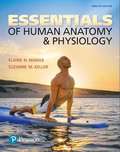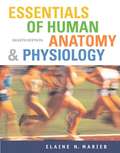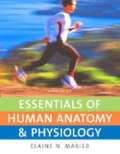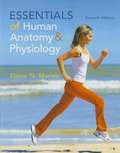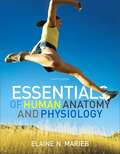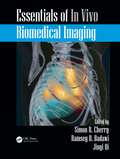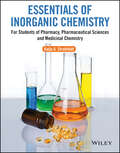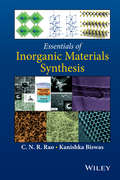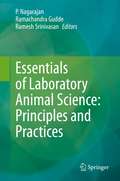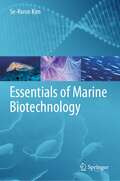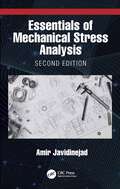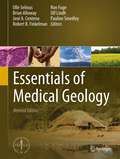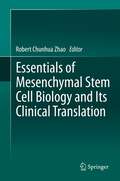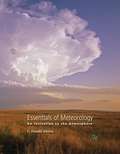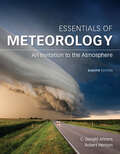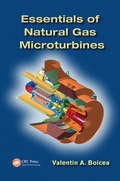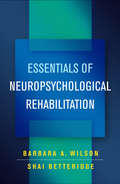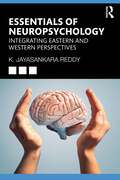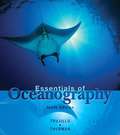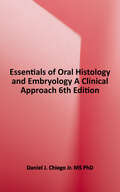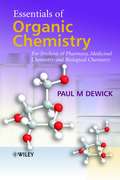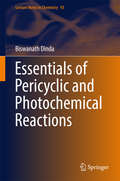- Table View
- List View
Essentials of Human Anatomy And Physiology (7th edition)
by Elaine N. MariebAnatomy and physiology, subdivisions of biology, explore many of these topics as they describe how our bodies are put together and how they work.
Essentials of Human Anatomy and Physiology
by Suzanne Keller Elaine MariebThoroughly updated with dozens of new figures, photos, and current information on medical recommendations and terminology, the 12th Edition continues to set the standard for brief, accessible one-semester A&P texts. The authors’ hallmark clear and friendly writing style has been strengthened with familiar analogies and abundant mnemonic cues that help in learning and remembering concepts. Continuing to offer just the right balance of anatomy, physiology, and clinical coverage, engaging new chapter previews help learners hone in on what structures and functions they are studying, how they function, and why they are important to learn.
Essentials of Human Anatomy and Physiology
by Elaine Marieb<i>Essentials of Human Anatomy and Physiology, Eighth Edition</i> continues to set the standard for A&P texts by helping readers better visualize and understand the structure and function of the human body. New information on hot topics like DNA fingerprinting, bone implants for children, stem cell research, and obesity draws readers into the material. Elaine Marieb's clear and friendly writing style emphasizes the relevance of anatomy and physiology to readers' lives and careers. It clarifies concepts, defines key terms, and offers just the right balance of anatomy, physiology, and clinical coverage to make the content complete without being overwhelming.
Essentials of Human Anatomy and Physiology (4th edition)
by Elaine N. MariebThe fourth edition is designed to introduce students pursuing careers in the allied health fields to the structure and function of the human body. Many sections dealing with timely topics, such as immunology and clinical advances, have been updated and the discussions of protein synthesis, muscle contraction, nutrition, and acid-base balance have been expanded. The style and presentation help students grasp the fundamental concepts of human anatomy and the inner workings of the body.
Essentials of Human Anatomy and Physiology (9th edition)
by Elaine N. MariebThis text introduces students to the structure and function of the human body. Marieb, an R.N. and Ph.D. who teaches at Edison Community College and Holyoke Community College, designed this book for students pursuing careers in the allied health fields but who may have limited previous exposure to the sciences. Sections discuss immunology and clinical advances based on current research, and throughout the book emphasizes career orientation through interviews with working professionals.
Essentials of Human Anatomy and Physiology (Eleventh Edition)
by Elaine N. MariebNote :Please note that the Lab manual, CD and Access code are available as seperate packages which are listed below but not included in the above title : This package contains: "0321750012": Essentials of Human Anatomy & Physiology Laboratory Manual "0321754182": Practice Anatomy Lab 3.0
Essentials of Human Anatomy and Physiology (Third Edition)
by John W. HoleEssentials of Human Anatomy and Physiology, Third edition, is designed to provide accurate information about the structure and function of the human body in an interesting and readable manner.
Essentials of Human Anatomy and Physiology Tenth Edition
by Elaine N. MariebNow in its Tenth Edition, Essentials of Human Anatomy & Physiology continues to set the standard for short-course A&P texts. Its dramatically updated art program, more streamlined presentation of material, and integration of chapter objectives will help you better visualize and understand the structure and function of the human body. Elaine Marieb's clear and friendly writing style emphasizes the relevance of anatomy & physiology to your life and future career. The book clarifies concepts, defines key terms, and offers just the right balance of anatomy, physiology, and clinical coverage to make the content complete without being overwhelming. Elaine Marieb wrote this book specifically for the one-semester course and continues to carefully select a range of material that proves just right for the shorter course. New information on hot topics like the HPV Vaccine, Infantile Polycystic Kidney disease, and Sudden Infant Death Syndrome (SIDS) draws students into the material. This package contains: Essentials of Human Anatomy and Physiology, Tenth Edition
Essentials of In Vivo Biomedical Imaging
by Simon R. Cherry Ramsey D. Badawi Jinyi QiWhile there are many excellent texts focused on clinical medical imaging, there are few books that approach in vivo imaging technologies from the perspective of a scientist or physician-scientist using, or interested in using, these techniques in research. It is for these individuals that Essentials of In Vivo Biomedical Imaging is written.Featurin
Essentials of Inorganic Chemistry
by Katja A. StrohfeldtA comprehensive introduction to inorganic chemistry and, specifically, the science of metal-based drugs, Essentials of Inorganic Chemistry describes the basics of inorganic chemistry, including organometallic chemistry and radiochemistry, from a pharmaceutical perspective. Written for students of pharmacy and pharmacology, pharmaceutical sciences, medicinal chemistry and other health-care related subjects, this accessible text introduces chemical principles with relevant pharmaceutical examples rather than as stand-alone concepts, allowing students to see the relevance of this subject for their future professions. It includes exercises and case studies.
Essentials of Inorganic Materials Synthesis
by C. N. Rao Kanishka BiswasThis compact handbook describes all the important methods of synthesis employed today for synthesizing inorganic materials. Some features: Focuses on modern inorganic materials with applications in nanotechnology, energy materials, and sustainability Synthesis is a crucial component of materials science and technology; this book provides a simple introduction as well as an updated description of methods Written in a very simple style, providing references to the literature to get details of the methods of preparation when required
Essentials of Laboratory Animal Science: Principles and Practices
by Ramesh Srinivasan P. Nagarajan Ramachandra GuddeThis book comprehensively reviews the anatomy, physiology, genetics and pathology of laboratory animals as well as the principles and practices of using laboratory animals for biomedical research.It covers the design of buildings used for laboratory animals, quality control of laboratory animals, and toxicology, and discusses various animal models used for human diseases. It also highlights aspects, such as handling and restraint and administration of drugs, as well as breeding and feeding of laboratory animals, and provides guidelines for developing meaningful experiments using laboratory animals.Further, the book discusses various alternatives to animal experiments for drug and chemical testing, including their advantages over the current approaches. Lastly, it examines the potential effect of harmful pathogens on the physiology of laboratory animals and discusses the state of art in in vivo imaging techniques.The book is a useful resource for research scientists, laboratory animal veterinarians, and students of laboratory animal medicine.
Essentials of Marine Biotechnology
by Se-Kwon KimThis textbook introduces marine biotechnology by collecting the key knowledge on genetics, fish breeding, genetic diversity, seaweed production and microalgae biotechnology, and explores marine biomaterials and how they can benefit human health. Covering the latest applications of marine biotechnology in natural product development, genomics, transgenic technology, cosmeceuticals, nutraceuticals, and pharmaceutical development, it particularly focuses on future biological resources, developing functional materials from marine life, production of marine bioenergy and marine microbial resources and biotechnology. The author explains the structure of the book in an introductory note, and each chapter offers a detailed overview and conclusion to help readers better grasp the acquired knowledge. Lastly, the final part provides a comprehensive glossary with brief explanations of the key concepts in marine biotechnology. Written by a leading expert in the field with more than 30 years of teaching experience, this book broadens students’ understanding of the basics and recent developments in marine biotechnology.
Essentials of Mechanical Stress Analysis (Mechanical And Aerospace Engineering Ser.)
by Amir JavidinejadEssentials of Mechanical Stress Analysis, updated for the second edition, covers stress analysis from an interdisciplinary perspective. Discussing techniques and theories essential to analysing structures, the book covers both analytical and numerical approaches. The second edition adds new topics and updates research to follow current advances in the field. New sections on material properties, composite materials and finite element analysis enable the reader to further establish the fundamental theory behind material behaviour and the causes of stress and strain. Also covering beams, plates, columns and elastic instability, the book discusses fatigue, life cycle, energy methods and MathCAD sample code. As a clear and comprehensive guide to stress and structural analysis, this book is relevant to students and scholars in the fields of mechanical, aerospace and civil engineering, as well as materials science.
Essentials of Medical Geology
by Olle Selinus Brian Alloway Jose Centeno Pauline Smedley Robert Finkelman Ron Fuge Ulf LindhEssentials of Medical Geology reviews the essential concepts and practical tools required to tackle environmental and public health problems. It is organized into four main sections. The first section deals with the fundamentals of environmental biology, the natural and anthropogenic sources of health elements that impact health and illustrate key biogeochemical transformations. The second section looks at the geological processes influencing human exposure to specific elements, such as radon, arsenic, fluorine, selenium and iodine. The third section presents the concepts and techniques of pathology, toxicology and epidemiology that underpin investigations into the human health effects of exposure to naturally occurring elements. The last section provides a toolbox of analytical approaches to environmental research and medical geology investigations. Essentials of Medical Geology was first published in 2005 and has since won three prestigious rewards. The book has been recognized as a key book in both medical and geology fields and is widely used as textbook and reference book in these fields. For this revised edition, editors and authors have updated the content that evolved a lot during 2005 and added two new chapters, on public health, and agriculture and health. This updated volume can now continue to be used as a textbook and reference book for all who are interested in this important topic and its impacts the health and wellbeing of many millions of people all over the world. · Addresses key topics at the intersection of environmental science and human health · Developed by 60 international experts from 20 countries and edited by professionals from the International Medical Geology Association (IMGA) · Written in non-technical language for a broad spectrum of readers, ranging from students and professional researchers to policymakers and the general public · Includes color illustrations throughout, references for further investigation and other aids to the reader
Essentials of Mesenchymal Stem Cell Biology and Its Clinical Translation
by Robert Chunhua ZhaoMesenchymal stem cells (MSCs), a type of adult stem cells, have attracted the attention of scientists and physicians alike due to their unique biological properties and potential for disease treatment. As stem cell research is complex and progressing rapidly, it is important that the experts in this field share their views and perspectives. This book, co-edited by leading global researchers, is divided into three major sections and covers a broad range of topics concerning MSCs during their transition from benchside to bedside. The book is intended for researchers and clinicians in the field of stem cells. Dr. Robert Chunhua Zhao, MD. Ph.D is Cheung Kong Professor of Stem Cell Biology, Professor of Cell Biology at the Institute of Basic Medical Sciences & School of Basic Medicine, Chinese Academy of Medical Sciences & Peking Union Medical College, China Director of Center for Tissue Engineering, PUMC Chief scientist of 973 program Regional Editor of Stem Cells and Development.
Essentials of Meteorology: An Invitation to the Atmosphere
by C. Donald AhrensThis updated and enhanced seventh edition of ESSENTIALS OF METEOROLOGY is written by the most widely read and authoritative author in introductory meteorology-Donald Ahrens. Ahrens's ability to explain relatively complicated ideas in a student-friendly, manageable fashion allows even non-science students to visualize the principles of meteorology. The text's clear and inviting narrative is supplemented by numerous pedagogical features that encourage observing, calculating, and synthesizing information. New critical thinking questions linked to key figures and concept animation boxes point to online animations and appendices allowing students to immediately apply the text material to the world around them--and understand the underlying meteorological principles.
Essentials of Meteorology: An Invitation to the Atmosphere (Mindtap Course List Series)
by Robert Henson C. Donald AhrensESSENTIALS OF METEOROLOGY, 8th Edition, is written for students interested in gaining insights into the dynamic workings of the atmosphere. The authors' ability to explain relatively complicated ideas in an easy-to-understand way lets both science and nonscience majors visualize the principles of meteorology.
Essentials of Natural Gas Microturbines
by Valentin A. BoiceaAddressing a field which, until now, has not been sufficiently investigated, Essentials of Natural Gas Microturbines thoroughly examines several natural gas microturbine technologies suitable not only for distributed generation but also for the automotive industry. An invaluable resource for power systems, electrical, and computer science engineers
Essentials of Neuropsychological Rehabilitation
by Barbara A. Wilson Shai BetteridgeFor people with disabilities caused by nonprogressive brain injury, challenges in everyday living can be multifaceted and overwhelming. This book presents key principles of holistic neuropsychological rehabilitation, helping practitioners stay on track through complex terrain. Leading authorities Barbara A. Wilson and Shai Betteridge provide a framework for effective intervention based on a collaborative understanding of clients' strengths and needs. They describe essential strategies for assessing and remediating the impact of cognitive and psychosocial problems in everyday life. Detailed case examples illustrate the process of building partnerships with families, setting meaningful goals, developing skills and supports, and addressing emotional and mental health concerns. Innovative uses of technology are highlighted. Several reproducible clinical tools can be downloaded and printed in a convenient 8 1/2" x 11" size.
Essentials of Neuropsychology: Integrating Eastern and Western Perspectives
by K. Jayasankara ReddyThis comprehensive textbook offers a holistic integration of both the research and clinical aspects of neuropsychology. Combining Eastern and Western perspectives, it explores latest developments, current scope, and significant challenges in the field to provide a detailed understanding of brain and behavior from research and intervention methods to rehabilitation and applications. Each chapter in the book includes an introduction to the topic, an overview of the latest research in the field, and a discussion of the future directions that research can take. The book is structured into three parts, each addressing specific aspects of the field. Part 1 introduces the readers to the fundamental principles of neuropsychology, including the available methods of assessment, brain anatomy, and its connection with human psychology. It provides an indepth look at neuropsychological and electrophysiological methods and their applications in clinical practice. Part 2 focuses on the brain and cognition, examining the complex mechanisms that underlie cognitive behavior. The chapters include neuropsychology of various executive functions, memory, and social cognition. Part 3 delves into clinical disorders and their biological basis. This section explores the disorders that have a direct relationship between brain functioning and behavior, offering valuable insights into their diagnosis, treatment, and management. It is an essential resource for both students in clinical neuropsychology and professionals seeking to expand their knowledge and stay abreast of the latest developments.
Essentials of Oceanography (10th edition)
by Harold V. Thurman Alan P. TrujilloTrujillo and Thurman present in-depth discussions of oceanographic concepts and demystify the science even for non-science students. Their systems approach highlights the relationship between oceanographic phenomena and how those phenomena affect other Earth systems. Scientific information from geology, chemistry, physics, and biology combine to illustrate how each of these disciplines relates to the ocean.
Essentials of Oral Histology and Embryology: A Clinical Approach, 6th Edition
by Daniel J. ChiegoEssentials of Oral Histology and Embryology: A Clinical Approach, 6th Edition uses a patient-centered approach to help dental professionals build a strong foundation in oral biology and basic science. It provides clear explanations of the anatomy of oral and facial tissues - and normal and abnormal orofacial development - so that you can provide effective oral health care for all patients. In addition to the stages of tooth development, it covers eruption and shedding of teeth, plus the parts of teeth - including enamel, dentin, dental pulp, and cementum. Written by Daniel J. Chiego, Jr., a noted dental educator and researcher, this book gives you the knowledge you need to succeed in the classroom and in clinical practice. Cutting-edge content provides essential knowledge of the basics of oral biology with a focus on practical clinical application. Clinical Comment, Consider the Patient, Quandaries in Science, and Case Study boxes apply scientific content to everyday dental practice and explore the boundaries of scientific research. Self-evaluation questions and practice quizzes help you prepare for classroom and national board exams. NEW! Coverage of COVID-19 includes how the virus affects the oral cavity. Updated full-color illustrations, micrographs, and histographs add to the already robust art program that supplements content by depicting various stages within the development of oral structures.
Essentials of Organic Chemistry
by Paul M. DewickEssentials of Organic Chemistry is an accessible introduction to the subject for students of Pharmacy, Medicinal Chemistry and Biological Chemistry. Designed to provide a thorough grounding in fundamental chemical principles, the book focuses on key elements of organic chemistry and carefully chosen material is illustrated with the extensive use of pharmaceutical and biochemical examples.In order to establish links and similarities the book places prominence on principles and deductive reasoning with cross-referencing. This informal text also places the main emphasis on understanding and predicting reactivity rather than synthetic methodology as well as utilising a mechanism based layout and featuring annotated schemes to reduce the need for textual explanations.* tailored specifically to the needs of students of Pharmacy Medical Chemistry and Biological Chemistry* numerous pharmaceutical and biochemical examples* mechanism based layout* focus on principles and deductive reasoningThis will be an invaluable reference for students of Pharmacy Medicinal and Biological Chemistry.
Essentials of Pericyclic and Photochemical Reactions
by Biswanath DindaThis book provides a concise introduction to pericyclic and photochemical reactions for organic synthesis. In the first part about pericyclic reactions, the author explains electrocyclic reactions, cycloaddition reactions, sigmatropic rearrangements, and group transfer reactions. The second part on photochemistry is dedicated to photochemical reactions of a variety of compound classes, including alkenes, dienes, and polyenes, carbonyl compounds, and aromatic compounds. Additionally, photofragmentation reactions are described in a dedicated chapter. The last chapter gives an outlook on applications of photochemistry and natural photochemical phenomena. Both parts start with a comprehensive presentation of the general principles of the pericyclic and photochemical reactions. All chapters are rich in examples, which help illustrate the explained principles and establish ties to results and trends in recent research. Additionally, each chapter offers exercises for students, and solutions to the problems are provided in a separate appendix. This book nicely illustrates the utility of pericyclic and photochemical reactions and provides students and researchers with the tools to apply them routinely for an efficient synthesis of complex organic molecules. It will therefore appeal to advanced undergraduate students, graduate and postgraduate students, and even to practitioners and scientists in the field of organic synthesis. The rich examples and exercises will also make it a versatile tool for teachers and lecturers.

